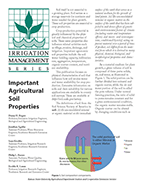Displaying 46 to 60 of 93 Publications
Important Agricultural Soil Properties
by Danny H. Rogers Jonathan Aguilar Isaya Kisekka Philip L. Barnes Freddie R. Lamm
L935
It is important that producers understand how soil properties influence tillage, erosion, and irrigation. This publication explains the relationship between soil properties and water availability for crop production. 8-page, color.Published Date: Jan 2015
Urban Water Quality Best Management Practices
by Aleksey Y. Sheshukov Stacy L. Hutchinson Trisha Moore
MF2732
Best management practices can help urban water quality systems retain runoff and filter pollutants. Techniques outlined here provide a brief overview of how these systems can be designed and adapted to different circumstances relevant to an urban environment. 4 pages, color.Revision Date: Apr 2017
Effects of Conservation Practices on Water Quality: Sediment
by Kent A. McVay Daniel L. Devlin Jeffery Neel
MF2682
The quality of water downstream depends on management of non-point sources within the watershed. It is important for land managers to do their part to farm in a stable system.Published Date: Jul 2005
Suspended Solids: A Water Quality Concern for Kansas
by Daniel L. Devlin Kent A. McVay
MF2501
The major source of suspended solids is cropland. Other sources include roadways, ditches, building sites, streambanks, grazinglands, livestock confinement operations, urban areas, and forestlands.Published Date: Feb 2001
Estimating Manure Nutrient Availability
by Dale F. Leikam Ray E. Lamond
MF2562
Managing manure for efficient crop production, while minimizing potential environmental concerns, is more complex than simply disposing of the manure on agricultural lands.Published Date: Jan 2003
Water Quality Best Management Practices, Effectiveness, and Cost for Reducing Contaminant Losses from Cropland
MF2572
This publication lists best management practices for reducing nutrient losses from cropland. 4-page, 2-color.Revision Date: Aug 2015
Water Quality Protection: Best Management Practices for Cropland
MF2462
Chart describing best way to control pollutants when using Alachlor, Atrazine, phosphorus, & nitrogen in crop production.Published Date: Aug 2000
Best Management Practices for Phosphorus
by Kent A. McVay Gary M. Pierzynski Daniel L. Devlin
MF2321
When excess phosphorus enters lakes and streams, it enhances the growth of algae and other aquatic weeds. This results in eutrophication, which eventually chokes out other life, depletes oxygen.Revision Date: Aug 2002
Soil, Water and Plant Relationships
L904
Knowing how plants use water and how soil and water interact can help producers on irrigated farm ground make better management decisions. This publication helps farmers make the most of limited irrigation resources. 8-page, color.Revision Date: Dec 2014
Terrace Maintenance
by G. Morgan Powell Kent A. McVay
C709
Information on how to maintain agricultural terraces with adequate capacity, ridge height and channel width to accomplish soil and water conservation. 8-page, 2-color.Revision Date: Jul 2004
Environmental Regulation Guide for Rural Kansans
by Peter Tomlinson et al.
MF2890
Laws and regulations, which may affect landowners, can be confusing. This guide is intended as an introduction to laws and regulations with which landowners may need to comply. It should help the reader identify basic regulatory concepts and find where to go for compliance information. Includes agency contact information. 8-page, b/w.Revision Date: Jun 2017
Best Management Practices for Nitrogen
by Daniel L. Devlin David A. Whitney Ray E. Lamond
MF2202
Use optimum nitrogen amounts, apply no more than necessary. Use the right source of nitrogen for situation. Apply nitrogen at the right time, either as one application or split applications.Published Date: Apr 1996
Kansas Prescribed Burning – Rules and Regulations
by Roger A. McEowen Carol Baldwin
MF3601
This publication allows persons engaged in prescribed burning activities to accurately assess the risks of prescribed burning, and provides attorneys with the necessary information to properly advise clients. 4 pages, color.Published Date: Aug 2022
Decision Considerations for Expiring CRP Contracts
by Carol Blocksome Rodney D. Jones Kevin L. Herbel
MF2827
Conservation Reserve Program landowners have options, including: keeping land under CRP contract, using land for crops, or using land for forage and/or livestock production. 4-page.Published Date: Mar 2008
No-till Wheat Management
by James P. Shroyer Alan Schlegel Brian L. S. Olson
MF2902
Fertility, planting, variety selection, weather, pest management, and grazing concerns are important to the success of no-till wheat. 4-page, color.Published Date: Oct 2009
Displaying 46 to 60 of 93 Publications
 Sign in
Sign in















